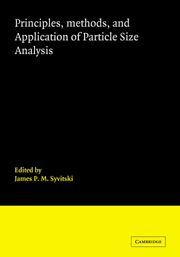Preface
Published online by Cambridge University Press: 28 January 2010
Summary
In 1983, members of the International Union of Geological Sciences – Committee on Sedimentology (IUGS–COS) expressed concerns on the state of automated particle size instruments used in the earth sciences and their apparent lack of calibration. The concerns of Professor E. Seibold (past president, IUGS) centered on the proliferation of user-built instruments (such as settling towers), that were essentially one of a kind and uncalibrated in the traditional analytical sense. Particle size information was typically reported in the international literature without concern for the analytical errors associated with such results. Were some of the presented data overinterpreted, considering the sampling, subsampling, and analytical techniques employed?
The IUGS–COS struck a working group on “modern methods of grain size analysis” in 1984, and I was asked by Dr. K. A. W. Crook (AUN, chairman IUGS–COS) to be its convener. Our objective was to determine the precision and accuracy of modern automated methods of particle size analysis and the role of these methods in investigation of earth processes and properties. Two meetings were convened (Dart-mouth, Canada, in 1985, and Heidelberg, Germany, in 1987) with participants representing twenty countries. The working group agreed to initiate and participate in a world calibration experiment for particle size analyzers (see Chapter 13), and to publish these results together with overviews on automated instruments and the theory of particle size characterization.
Our result is this textbook formulated to address the needs of both students and research professionals in the earth science and oceanographic community.
Information
- Type
- Chapter
- Information
- Publisher: Cambridge University PressPrint publication year: 1991
